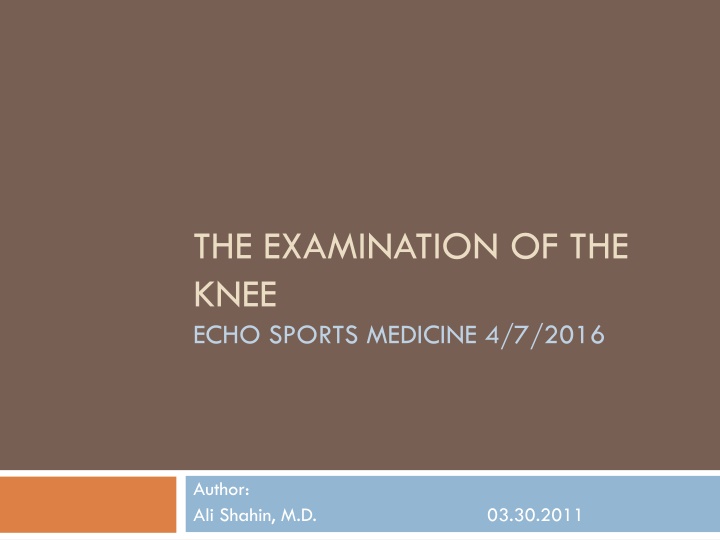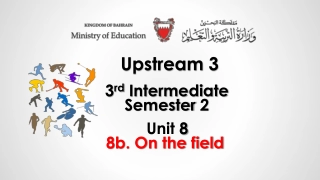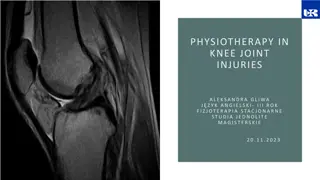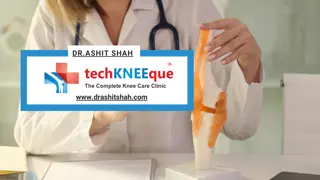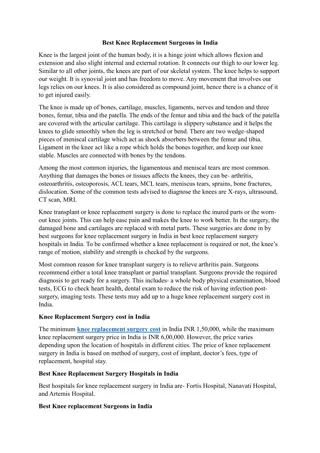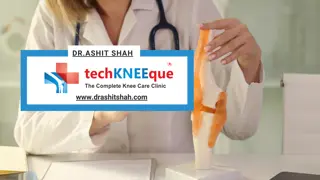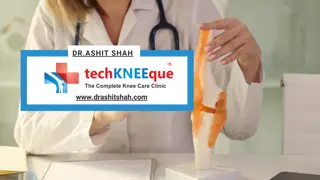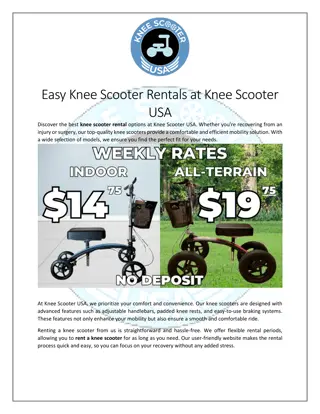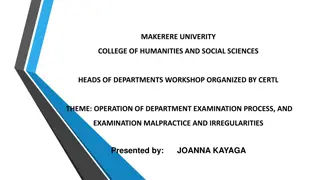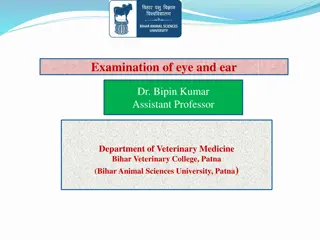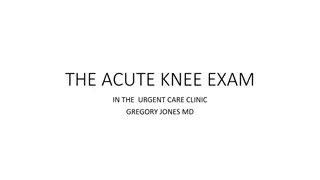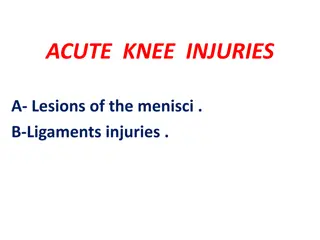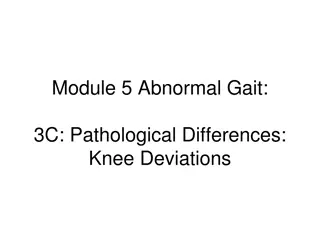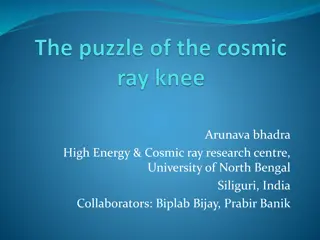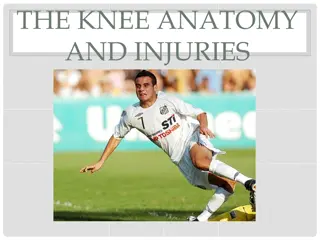Comprehensive Knee Examination in Sports Medicine
In this guide, you will learn how to effectively conduct a thorough examination of the knee joint. From identifying ligament sprains and tears to assessing for various injuries and conditions such as meniscus injuries, patellofemoral syndrome, and Osgood-Schlatter Disease, this resource provides detailed insights and techniques for examination and palpation. Visual aids and step-by-step instructions aid in understanding the process.
Download Presentation

Please find below an Image/Link to download the presentation.
The content on the website is provided AS IS for your information and personal use only. It may not be sold, licensed, or shared on other websites without obtaining consent from the author.If you encounter any issues during the download, it is possible that the publisher has removed the file from their server.
You are allowed to download the files provided on this website for personal or commercial use, subject to the condition that they are used lawfully. All files are the property of their respective owners.
The content on the website is provided AS IS for your information and personal use only. It may not be sold, licensed, or shared on other websites without obtaining consent from the author.
E N D
Presentation Transcript
THE EXAMINATION OF THE KNEE ECHO SPORTS MEDICINE 4/7/2016 Author: Ali Shahin, M.D. 03.30.2011
Objective Learn how to do a quick and thorough knee exam Be able to identify Collateral ligament sprains/tears (LCL, MCL) Cruciate ligament sprains/tears (ACL, PCL) Meniscus injuries Patellofemoral syndrome Osteoarthritis Osgood Schlatter Disease Patellar tendinitis Pes anserine bursitis Illiotibial (IT) Band syndrome
Inspection Swelling/effusion, erythema, ecchymosis Knee angle Genu varum (bowed legs) Genu valgum (can predispose to patellofemoral syndrome)
Palpation Palpate the patient in the sitting position Start with the joint line
Palpation Joint line tenderness: Meniscal injury Osteoarthritis Fracture
Palpation Next, find the inferior pole of the patella and palpate the patella tendon down to its insertion at the tibial tuberosity
Palpation Area of tenderness and probable swelling Likely causes Inferior pole of patella Sinding-Larsen-Johansson syndrome Patellar tendon Patellar tendinopathy Patellar rupture Patellar insertion at tibial tuberosity Osgood-Schlatter-Disease
Palpation When you are at the tibial tuberosity palpate with your finger 1-2 cm medially If the patient is tender there, consider Pes anserine bursitis
Palpation Have the patient lay supine Start with palpating: Medial and lateral femoral and tibial (epi)condyles & the fibular head: Medial collateral ligament (MCL) sprain Lateral collateral ligament (LCL) sprain Iliotibial (IT) band syndrome Tibial plateau fracture Fibular head fracture
Palpation IT-band syndrome
Palpation Effusion: Milking Effusion is assessed by "milking" fluid distally from the suprapatellar pouch Place one hand on the supra-patellar pouch. Gently push down and towards the patella, forcing any fluid to accumulate in the central part of the joint Palpate the area adjacent to the patellar tendon for fluid accumulation If equivocal, compare with the other knee
Palpation Effusion: Ballottement A ballotable patella may be palpated after similar effusion milking Place one hand on the supra- patellar pouch. Gently push down and towards the patella, forcing any fluid to accumulate in the central part of the joint Gently push down on the patella with your thumb If there is a sizable effusion, the patella will feel as if it is floating and bounce back up when pushed down
Palpation After a trauma there is effusion (hemarthrosis) only if structures in the joint are involved: Anterior cruciate or posterior cruciate ligament (ACL, PCL) injury Meniscus injury Patellar dislocation Intra-articular fracture (e.g. tibial plateau fracture) Remember: Sole collateral ligament (MCL, LCL) sprains will not cause an effusion Causes of non-traumatic effusion: Osteoarthritis, rheumatoid arthritis, gout, pseudo gout, Reiter s syndrome Infections e.g. gonorrhea Tumors
Inspection Patellofemoral syndrome (PFPS) The J sign The patient supine or seated and the knee extended from a flexed position. Lateral deviation of the patella can be observed during the terminal phase of extension
Palpation Next, clinical tests for patellar mobility and position, and provocative tests for pain should be performed: patellar glide patellar tilt and patellar grind tests Positive results on these tests are consistent with the diagnosis of PFPS The patellar apprehension test is used to assess for lateral instability and is positive when pain or discomfort occurs with lateral translation of the patella
Palpation Patellar glide Assesses patellar mobility Displacement of more than three quadrants suggests patellar hypermobility caused by poor medial restraints predisposing for PFPS Also, palpate the medial & lateral undersurface of the patella
Palpation Patellar tilt Positive test = lateral aspect of patella is fixed and cannot be raised to at least horizontal position Indicates tight lateral structures (e.g.: IT-band) predisposing for PFPS
Palpation Patellar grind test The patient is in the supine position with the knee extended The examiner displaces the patella inferiorly into the trochlear groove The patient is then asked to contract the quadriceps while the examiner continues to palpate the patella and provides gentle resistance to superior movement of the patella The test is indicative of PFPS if pain is produced
Palpation Apprehension test Patient is apprehensive if the examiner tries to move the patella laterally Positive after patellar (sub)luxation and in severe PFPS
Range Of Motion (ROM) Test for active & passive ROM while the patient is supine Flexion 140 Extension 0 /-10 Internal rotation 10 External rotation 10 Always compare to the other, healthy knee!
Special Tests: MCL Apply valgus stress with the knee at 0 and bent at 30 0 tests for MCL as well as the cruciate ligaments 30 only tests the MCL Pain speaks for mild sprain Pain & laxity speak for moderate sprain No fix endpoint speaks for complete MCL rupture
Special Tests: LCL Apply varus stress with the knee at 0 and bent at 30 0 tests for LCL as well as the cruciate ligaments 30 only tests the LCL Pain speaks for mild sprain Pain & laxity speak for moderate sprain No fix endpoint speaks for complete LCL rupture
Special Tests: ACL Lachman test Patient supine with knee flexed 30 Pull on the tibia towards you Anterior drawer test Patient supine with knee flexed 90 Stabilize patient s foot by sitting on it Cup your hands around patient s knee & draw the tibia towards you
Special Tests: ACL Lachman & anterior drawer test are positive if There is increased amount of anterior tibial translation compared with the opposite leg, and/or There is no firm end-point
Special Tests: ACL Sensitivity Specificity Lachman test 85%[1] 94%[1] Anterior Drawer test 68%[2] 79%[2] Pivot Shift test 24%[1] 98%[1] [1] Benjaminse A, Gokeler A, van der Schans CP. Clinical diagnosis of an anterior cruciate ligament rupture: a meta-analysis. J Orthop Sports Phys Ther. 2006 May;36(5):267-88. [2] Kim SJ, Kim HK. Reliability of the anterior drawer test, the pivot shift test, and the Lachman test. Clin Orthop Relat Res. 1995 Aug;(317):237-42.
Special Tests: PCL Posterior drawer test Stay in the same position as for the anterior drawer test Push the tibia posteriorly If it moves backwards the PCL is probably damaged
Special Tests: PCL Another way of testing the PCL is the sag sign
Special Tests: PCL Sag sign
Special Tests: Meniscus Mc Murray Hold the knee with one hand, place your fingers along the joint line and flex it to 90 Hold the foot by the sole with the other hand
Special Tests: Meniscus Mc Murray (cont) Provide a valgus stress Rotate the leg externally Extend the knee If pain or a click is felt = positive McMurray for a medial meniscus tear
Special Tests: Meniscus Mc Murray (cont) Provide a varus stress Rotate the leg internally Extend the knee If pain or a click is felt = positive McMurray for a lateral meniscus tear
Special Tests: Meniscus Apley grind test The patient lays prone and flexes his/her knee 90 Place your hand on the patient s heel and push down (to compress the menisci between femur & tibia) while rotating internally & externally Depending on the area of pain medial or lateral meniscus tear
Special Tests: IT-band Syndrome Ober s Test The patient lies with the unaffected side down and the unaffected hip and knee at a 90-degree angle. If the IT-band is tight, the patient will have difficulty adducting the leg beyond the midline and may experience pain at the lateral knee
Referred pain Knee pain can be referred from the lumbar spine (e.g. herniated disk) or from a hip or ankle pathology, so don t forget to Do a gross hip and ankle exam Test the motor strength, sensibility and deep tendon reflexes of the lower extremities And always examine both knees!
References Various articles from American Family Physician (www.aafp.org) Hoppenfeld Physical Examination of the Spine & Extremities Netter s Sports Medicine
